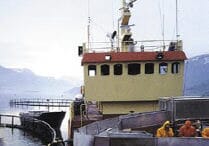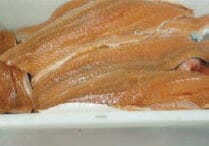
Therefore, the aim of this article is to identify risk factors for PD and ways of minimising the impact of PD (see also Agenda No. 5 and 6).
Some possible risk factors for a PD outbreak:
- History of PD on site or in coastal zone
- Fish strain
- Smolt type (S0 or S1)
- Multiple generation sites
- Sea site to sea site and harvest movements
- Site location
- Sharing equipment or personnel between sites
- Method and frequency of mortality removal
- Method of disposal of mortalities
- Slaughter methods and offal/effluent disposal
- Poor farm hygiene
- Biosecurity & disinfection
- Stocking densities/cage & total number of fish on site
- Feeding management
- Sea lice control
- Vaccination status
- Specific daily growth rate at periods of high risk
In order to control an infectious viral disease, it is important to know how the virus is spread, what the risk factors are that make spread more likely and where in the production cycle you take critical action to reduce the risks and impact of infection.
How is Salmon Pancreas Disease Virus spread and how can you stop it ?
- Live fish: direct fish to fish transmission is the main form of spread, through the excreta. (Horizontal spread)
- Do not move infected fish, use All in - All out systems.
- Dead fish and waste matter: while the length of survival of SPDV outside the fish has not been determined, it should be assumed that all PD mortalities may be infectious.
- Dead fish should be removed quickly and be incinerated or rendered.
- Inadequately treated
- Effluent treatment as for ISAV should be adequate.
- Contain all blood from infected stock.
- Movement of infected fish should be avoided where possible.
- Movement of infected fish to slaughter should be done in closed wellboat systems only.
- Effective sea lice control may help reduce challenge levels.
- Avoid sharing any of the above, but if necessary clean & disinfect.
 Figure 1: Wellboat transport may be a potential source of infection. |
 Figure 2: Fish which have had PD infection may have grey shades of melanin in large areas of the fillet. |
Dietary management has also been applied to reduce stress and aid recovery. Many farms withhold feed from all fish on site for 5-10 days upon suspicion of PD, as there was some circumstantial evidence that this reduced the impact and losses. However, in our experience, it may take 2-3 months for all pens on a site to become infected and the above feeding strategy may be causing unnecessary losses in production due to days off feed. It is also important that affected fish do not get too hungry as frantic feeding behaviour may exacerbate heart and
skeletal lesions.
If possible, dietary management should be on a cage by cage basis to optimise any effect and reduce consequent growth penalties. Remember, in the acute phase of the disease, the fish are unable to properly digest their feed due to the pancreatic damage; thus, it may take 3-6 weeks
for the pancreas to recover depending on the water temperature. A common sense approach is to reduce feeding when the appetite is poor, with a gradual return to maintenance levels to avoid hunger and only feeding for growth when the fish are fully recovered. Additional vitamin E and
C in the diets, which are excellent antioxidants, may aid tissue repair and recovery.
A PD vaccine has been in development since 1994 by Intervet. Initial extensive trials which started in 1997 with a prototype PDV antigen incorporated in the existing multivalent salmonid Norvax vaccine range, gave mixed results as it appeared that the PDV antigen was less efficacious in the presence of the other antigens in those vaccines. A two-stage vaccination strategy in freshwater has now been tested in both laboratory and commercial field trials in an attempt to protect salmon from PD. While it has proven to be very effective in some field trials, there are still some concerns about the long term duration of immunity.
PD vaccination should be targeted at sites with a serious history of PD in the first year at sea. Sea vaccination or revaccination is being currently investigated for sites where PD occurs in Atlantic salmon in the second year at sea. For an optimum effect, it is very important to use the PD vaccine in advance of other vaccines and with a short temperature-dependent period between vaccinations. For maximum effect, all fish in an area should be vaccinated. Fish viral vaccine development is still in its infancy and it will be some time before viral vaccines are optimised.
The aim at this stage should be to prime the immune response, reduce viral challenge in the face of an outbreak and reduce mortality. Any reduction in mortalities and or growth impact may be cost effective. Further improvements and the use of new technologies are to be expected in the near future.
September 2006

